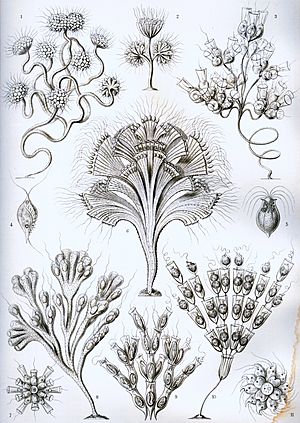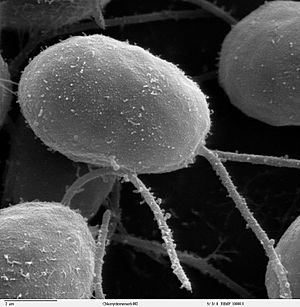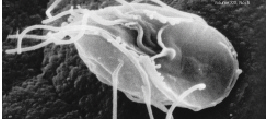Flagellate facts for kids
Flagellates are tiny cells that have one or more special whip-like parts called flagella. These flagella help them move around. You can find flagellates in many different living things.
For example, sperm cells in most animals are flagellates. They use their flagella to swim. While Flowering plants and fungi do not have flagellate cells, their relatives like green algae and chytrids do. Many protists are also single-celled flagellates.
Flagellates are found in almost all living things with complex cells, known as eukaryotes. Scientists believe that all eukaryotes alive today might have developed from ancient flagellate cells.
Contents
What Are Flagellates?
Flagellates are a type of cell that uses a special part called a flagellum to move. Imagine a tiny whip or a propeller on a boat; that's how a flagellum works. It spins or wiggles to push the cell through water or other liquids.
How Flagella Work
Each flagellum is made of tiny tubes called microtubules. These tubes are arranged in a specific pattern, usually nine pairs around the outside and two single ones in the middle. This arrangement helps the flagellum bend and move, making the cell swim.
Where Do We Find Flagellates?
Flagellates live in many different places and are part of many living things.
Flagellates in Animals
Many animal cells have flagella. The most common example is the sperm cell. Sperm cells use their single flagellum to swim towards an egg, which is important for reproduction.
Flagellates in Other Organisms
- Green Algae: Some types of green algae, like Chlamydomonas, are single-celled flagellates. They use their flagella to swim in water and find sunlight for food.
- Chytrids: These are a type of fungi that also have flagellate cells, which is unusual for fungi.
- Protists: A large group of tiny living things called protists includes many flagellates. Some protists live freely in water, while others can live inside other animals or plants.
Types of Flagellates
There are many different kinds of flagellates. Some are harmless and live freely, while others can be parasites.
Free-Living Flagellates
Many flagellates live in water, like ponds, lakes, and oceans. They are an important part of the food chain, eating tiny bits of food and being eaten by larger creatures.
Parasitic Flagellates
Some flagellates are parasites, meaning they live inside another living thing and can cause harm. For example, Giardia lamblia is a flagellate that can live in the intestines of humans and animals, causing stomach problems.
Related Cells
- Ciliate cells are similar to flagellates but have many tiny, hair-like structures called cilia. Cilia work like flagella but are usually shorter and cover the cell's surface.
See also
 In Spanish: Mastigophora para niños
In Spanish: Mastigophora para niños




